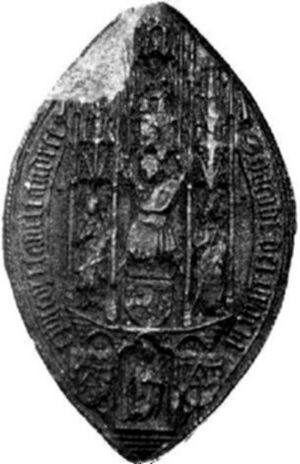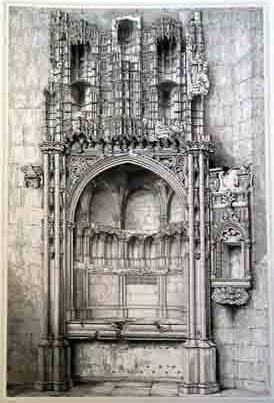James Kennedy (bishop) facts for kids
Quick facts for kids James Kennedy |
|
|---|---|
| Bishop of St Andrews | |
 |
|
| Church | Roman Catholic Church |
| See | Diocese of St Andrews |
| In Office | 1440–1465 |
| Predecessor | Henry Wardlaw |
| Successor | Patrick Graham |
| Orders | |
| Consecration | 1438 (Dunkeld) |
| Personal details | |
| Born | c. 1408 Carrick, Scotland |
| Died | 24 May 1465 St Andrews, Fife, Scotland |
| Previous post | Dunkeld |
James Kennedy (Scottish Gaelic: Seumas Ceanadach) was an important Scottish church leader in the 1400s. He was born around 1408 and died in 1465. He served as a bishop in two different places: first in Dunkeld and then in St Andrews. St Andrews was the most important church position in Scotland at the time. Kennedy also played a big role in the government of Scotland when King James III of Scotland was a child. He even founded a famous college called St Salvator's College in St Andrews.
Contents
Early Life and Education
James Kennedy was born around 1408 in Carrick, Scotland. He was the youngest of three sons. His father was Sir James Kennedy of Dunure. His mother was Princess Mary of Scotland, who was the daughter of King Robert III of Scotland. This made James Kennedy a grandson of a king!
He was sent to Europe to finish his education. There, he studied canon law, which are the laws of the church, and theology, which is the study of religious faith.
Becoming a Bishop
James Kennedy started his church career as a canon in Dunkeld. This meant he was a member of the clergy, helping the bishop. On July 1, 1437, he was chosen to become the Bishop of Dunkeld. He was officially made a bishop in 1438.
As Bishop of Dunkeld, he wanted to make improvements and fix problems within the church. He even went to a big meeting called the Council of Florence. This meeting was held in Florence, Italy. He hoped to get permission from Pope Eugenius IV for his plans. However, he did not stay Bishop of Dunkeld for very long.
Leading the Church in St Andrews
The most important church position in Scotland was the Bishop of St Andrews. When the previous bishop, Henry Wardlaw, died, James Kennedy was chosen to take his place. This happened while James was still in Florence at the Council. The Pope quickly approved his move to St Andrews. He officially became the Bishop of St Andrews on June 8, 1440.
He was a very active and successful bishop. He held his first mass in St Andrews Cathedral on September 30, 1442. He immediately continued his efforts to improve the church.
Kennedy's Role in Scottish Politics
During the time when King James III of Scotland was a child, James Kennedy became a very important figure in Scottish politics. He often helped to make peace between powerful noble families who were arguing.
In May 1444, he was made Chancellor of Scotland. This was a very high government job. However, he gave up the position just a few weeks later. He felt that his duties as Chancellor were getting in the way of his church work.
Kennedy also tried to help solve a big disagreement within the church itself. He traveled to Rome to try and bring different groups together. He got special permission to travel through England from King Henry VI. His efforts to solve the church's problems were not successful, and he soon returned home.
Founding St Salvator's College
In 1450, Bishop Kennedy founded St Salvator's College in St Andrews. He gave a lot of money and resources to the college. This was a very important step for education in Scotland. Pope Nicholas V officially approved his new college in 1451. Later, Pope Pius II also approved some changes to the college's rules.
Soon after, Kennedy also helped set up the Grey Friars monastery in St Andrews. He even built a large ship called the "Saint Salvator." This ship was very famous and was often used by royal family members. It was considered amazing until it was wrecked in 1472.
After King James II died in 1460, James Kennedy was chosen as one of seven regents. Regents are people who govern a country when the king is too young. Kennedy was put in charge of the kingdom and also had to keep the peace among the other nobles.
Death and Lasting Impact
James Kennedy died on May 24, 1465. He was buried in a grand tomb that he had built for himself. This tomb was located in St Salvator's Chapel. It is believed he got the design and materials for his tomb from Italy. Parts of his tomb can still be seen today.
People at the time thought very highly of Bishop Kennedy. They respected him both as a church leader and as a politician. Some even said he was better than all the bishops who came before or after him in St Andrews. He was praised for his strong desire to improve the church.
Kennedy is believed to have written several books. Two of the titles that are remembered are Historia sui Temporis (History of His Time) and Monita Politica (Political Advice).
In Fiction
Bishop Kennedy appears as a character in the book Black Douglas by Nigel Tranter. In this story, he is shown in a less positive way.


